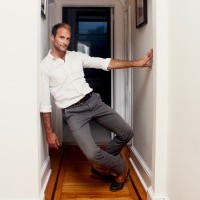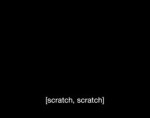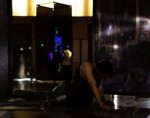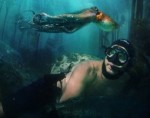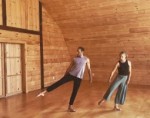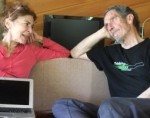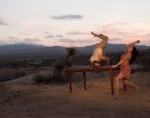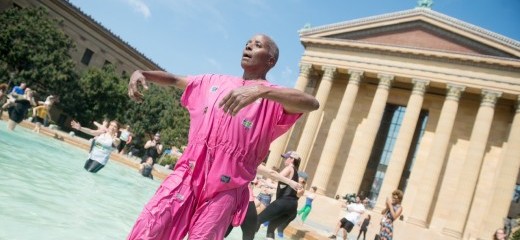
Levee des conflits: From the Inside Out
by Ellen Chenoweth and Beau Hancock
Boris Charmatz led a public workshop related to Levee des conflits on the plaza of the Philadelphia Museum of Art in early September. Beau participated in a series of workshops for professional dancers, and Ellen was documenting the workshops on social media. They wanted to re-visit the experience, which left a deep impression on both. The culminating workshop discussed here included both Philadelphia professional dancers and general public participants. Levee des conflits consists of 25 movements done in sequence. (For previous TD coverage, see Janna Meiring’s review of the stage work and Rhonda Moore’s description of participating in the professional workshop series.)
Dear Beau,
It was very, very hot that day. Boris started the workshop with having everyone do sit-ups on the concrete in the shade. I had been thinking about participating, but when I saw sit-ups in the crazy heat, I was like, “mmm, I'll watch instead.”
Suddenly there was music everywhere around the plaza. I think it was Earl Sweatshirt, and it was glitchy and non-melodic and loud. The music combined with the heat and bright light of the sun felt oppressive, and there was no escape from any of the elements. The group started performing the first movement, which looks like someone washing the floor with their hand, and all of a sudden, I felt my eyes fill with hot tears. I think it had something to do with the seriousness of the gesture, plus the vulnerability of the bodies, many of them wet or dripping.
Dear Ellen,
It was scorching hot. Just standing around waiting, I had beads of sweat trickling down my face. As the 75 or so dancers all warmed our way through the 25 movements of Levee des conflits on the Art Museum steps, I sensed my fellow dancers’ discontent. "Are you really going to do this?" a friend asked me. I knew we all would, even if begrudgingly. Yes it was hot, yes we would rather be inside, but we were committed. I think it should be noted that no one backed out.
It seems to me that Boris was tuned into the group needs, and he finally suggested that the performance take place in the fountain … to a group sigh of relief. I was skeptical about Levee until this point. The 25 gestures felt mechanical and constricting, verging on brutal. But this decision to move the performance into the fountain added much-needed fluidity, gave us a reprieve, made it juicy. I could also see in this moment that Boris was with us. This wasn't a tyrannical situation where the director sees his vision fulfilled despite the dancers’ desires, but a negotiation with all the elements present. I appreciated this care.
Entering the pool of the fountain was a deep relief! From inside I was thankful for the decision to move the performance off the scorching concrete, and not only because it was sweltering but because the fountain gave us a clear playing space, a boundary and symbol to unite around. And the water brought for me a lusciousness to the task-based movements, added dimension to the choreography’s rolling, rocking, rising, reaching, and resting. I was instantly soaked, and the weight of my clothes altered my movement, made me hyper-aware of how I completed each action. Every choice was magnified by the added elements—stone floor, fierce sun, gushing water.
I wonder what you saw, Ellen, that made it so emotional?
Dear Beau…
I think it felt emotional because it seemed like I was watching the present and the future at the same time. I've never had that sensation in the same way before.
It made me think of Octavia Butler's Parable of the Sower, like I was watching this dystopian future where water is the most precious resource, and like you had all been trudging outdoors for miles to reach this source. Once you arrived, everyone was hot and tired, and you were doing this mournful, heavy dance together. There's this movement where one person takes the shirt of the other person, and kind of tosses them to the ground (its shorthand name is "crocodile", as if the other person were a crocodile you were wrestling to the ground), and I saw people perform this potentially brutal movement with such care and tenderness, making sure that bodies were protected as they hit the ground. That was also incredibly moving.
A lot of site-specific works leave traces in the site, but some of the most indelible traces for me are from this experience and from witnessing Eiko at 30th Street Station. I never pass through the train station now without remembering Eiko's presence there. I'll never be on that plaza at the PMA without remembering your bodies and movements there, in and around the fountain.
Does this seem far-fetched to you? Am I imagining the dystopian element?
Dear Ellen…
I agree that the fountain in front of the art museum is irrevocably etched for me by that performance. I haven’t been back since, but I imagine having the urge to dive into those waters again, out of nostalgia, or a need to tap back into the connectivity I felt to the site, to the people, to myself in the moment of performance.
I said earlier that the water made the movement luscious, and you mention the care and tenderness you saw in certain gestures. There was this balance of soft and hard throughout. Just as water can be soft or hard depending on its energy, these 25 gestures could feel smooth and easy like gently lapping waves or manic and thrown as a tempest.
There is something heavy at the edge of this dance, and not simply my dripping, waterlogged pants.
Some dances expect the performer to be slightly removed, when the action is rigidly predetermined and your job as the dancer is to complete the script, an impeccably rehearsed script at times, but a script nonetheless. Work like Levee des conflits goes somewhere else, requires deep mining of self. These dances allow—or rather ask—for performer agency. To perform the work, to be fully immersed in its potential, the dancer must engage all parts of self, must let go of ego and attachment to performing and give themself over to the integrity of the structure. I felt this transcendence. I was “gone” for a moment, and fully present at the same time. I could keep track of where I was in the structure, but how I navigated each gesture, the gushing water, the other bodies, or the slippery ground is a blur. And in this moment of transformation, the water felt like a blessing, a ritual bath.
Which reminds me of what you said about the Butler story … isn’t there a part of all the water rituals we find throughout human history that reminds us that water is our most precious resource, that to take it lightly is to take our existence, our gift of embodiment, lightly? I remember thinking after the performance finished that this should happen every Saturday, that any community member willing to do the work to learn the choreography should have a chance to honor this resource and their body in this way.
Dear Beau,
I’m struck by how similar the experience felt inside of it and watching the piece. There is something heavy at the edge of this dance. You say you were “gone” and fully present at the same time. I felt like I was in the present and the future at the same time, as if linear time had folded upon itself at the point of the fountain. Like you all had charged that site so intensely that we were looking at both at once.
I also have the urge to re-visit. The connectivity that you mention is part of it, and also the absolute certainty that something extraordinary was unfolding. There was no way to know that this gorgeous, unforgettable thing was going to happen the way it did, no way to anticipate it, and then it was gone so quickly. Thank you for letting me remember with you.
By Ellen Chenoweth
January 14, 2017


